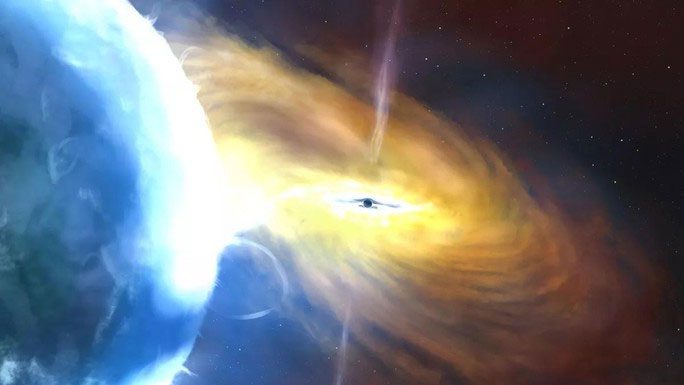Several Earth-based observatories have detected signals from a fiery ball unlike anything seen before, located a staggering 8 billion light-years away, yet shining as brightly as a supernova or a comet passing by at close range.
According to The Guardian, this fiery ball is 100 times larger than our Solar System, shining 2 million times brighter than the Sun, and has released energy in just the last three years equivalent to that of 100 stars that would typically have a lifespan of 10 billion years.

Graphic depiction of how the fiery ball appeared – (Image: John A. Paice/SPACE).
The light burst was first detected in 2022 by the Zwicky Transient Facility, a modern camera mounted on the Samuel Oschin Telescope at the Palomar Observatory in California, USA.
It was so bright that observers initially thought a previously unknown comet had just passed through Earth’s sky, or that a supernova—an exploding star—was occurring at a relatively close distance.
However, subsequent calculations astonished astronomers: the source of the explosive light is 8 billion light-years away from us.
Dr. Philip Wiseman, an astronomer from the University of Southampton (UK) and a member of the research team, noted that older data indicated the source of light had been in existence for over a year before it drew attention due to a sudden increase in brightness. It has continued to shine brightly for the past three years.
They believe that the explosion, coded AT2021lwx, is the result of a gigantic gas cloud, thousands of times larger than the Sun, unexpectedly plunging into the maw of a monstrous black hole from which it could not escape.
This catastrophic process has caused the black hole to transform into an unprecedented bright quasar, emitting tremendous energy across space-time, allowing even observers on Earth, far away, to witness it.
This is not the brightest phenomenon ever recorded. A gamma-ray burst detected last year was brighter but lasted only a few minutes. This fiery ball, after three years of explosive activity, continues to thrive, and the total energy released throughout this process will be significantly greater.


















































